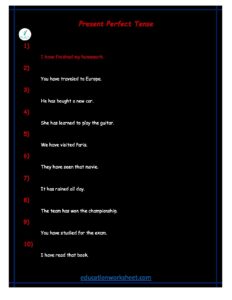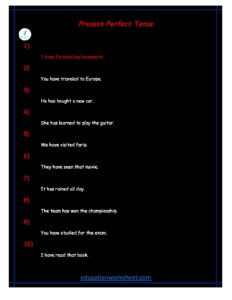how to converting Present Perfect Continuous Tense negative sentences to interrogative form 1
how to converting Present Perfect Continuous Tense negative sentences to interrogative form
The Present Perfect Continuous tense is a versatile and important aspect of English grammar. It is used to express actions or events that started in the past, continue into the present, and may continue into the future. Understanding how to convert negative sentences in the Present Perfect Continuous tense into interrogative forms is crucial for effective communication in English. In this comprehensive guide, we will explore the rules, structure, and examples of how to transform negative sentences into questions, with a focus on the Present Perfect Continuous tense.
I. Understanding the Present Perfect Continuous Tense

Before delving into the transformation of negative sentences to interrogative forms, it’s essential to grasp the basics of the Present Perfect Continuous tense.
The Present Perfect Continuous tense is formed by using the present tense of the auxiliary verb “have” (have/has), followed by “been,” and then the present participle of the main verb (the base verb + “-ing”). This tense is commonly used to:
- Describe actions or events that started in the past, continue into the present, and may continue into the future.
Example: She has been working at the company for five years.
- Emphasize the duration of an action or event.
Example: They have been studying English all morning.
- Express irritation or impatience when used with “how long.”
Example: How long have you been playing that loud music?
II. Negative Sentences in the Present Perfect Continuous Tense
Negative sentences in the Present Perfect Continuous tense are constructed by adding the word “not” after the auxiliary verb “have” or “has.”
Structure: Subject + (have/has) + not + been + present participle of the main verb.
Examples:
- She has not been working at the company for five years.
- They have not been studying English all morning.
- I have not been practicing the piano.
III. Transforming Negative Sentences into Interrogative Form
To convert negative sentences in the Present Perfect Continuous tense into interrogative form, follow these steps:
Step 1: Start with the auxiliary verb (have/has).
Step 2: Place the auxiliary verb (have/has) at the beginning of the sentence.
Step 3: Invert the subject and the auxiliary verb.
Step 4: Add a question word (if needed) at the beginning of the sentence.
Step 5: Place the main verb in the present participle form after the auxiliary verb.
Step 6: Add a question mark at the end of the sentence.
Let’s break down these steps with examples:
- Original Negative Sentence: She has not been working at the company for five years.
Interrogative Form: Has she been working at the company for five years?
- Original Negative Sentence: They have not been studying English all morning.
Interrogative Form: Have they been studying English all morning?
- Original Negative Sentence: I have not been practicing the piano.
Interrogative Form: Have I been practicing the piano?
IV. Using Question Words
Question words (also known as interrogative words) are often used in interrogative sentences to gather specific information. Common question words include:
- What
- Where
- When
- Why
- How
- Who
- Whose
- Which
- Whom
how to converting Present Perfect Continuous Tense negative sentences to interrogative form

Question words are placed at the beginning of the interrogative sentence and are followed by the auxiliary verb and the main verb in the Present Perfect Continuous tense. Here are examples using question words:
- What have you been doing all day?
- Where have they been traveling recently?
- When has she been practicing yoga?
- Why have we been waiting for so long?
- How has he been studying for the exam?
- Who has been cooking dinner?
- Whose car has been parked in front of the house?
- Which book has she been reading?
- Whom have you been talking to?
V. Asking Open-Ended and Closed-Ended Questions
In English, questions can be categorized into open-ended and closed-ended questions. Open-ended questions typically begin with question words like “what,” “where,” “when,” “why,” “how,” and “who.” These questions invite detailed, descriptive responses.
Example of an open-ended question: How have you been spending your summer vacation?
Closed-ended questions, on the other hand, are designed to elicit specific yes or no answers and are often formed without question words. Closed-ended questions typically begin with the auxiliary verb.
Example of a closed-ended question: Have you been studying for the test?
In the Present Perfect Continuous tense, both open-ended and closed-ended questions can be formed by following the same basic structure mentioned earlier.
VI. Practice Exercises
Now, let’s practice transforming negative sentences into interrogative forms. Try to convert the following negative sentences into questions:
- She has not been gardening all day.
- They have not been renovating the house for months.
- I have not been watching TV recently.
- He has not been learning Spanish for a long time.
- We have not been waiting here for hours.
Answers:
- Has she been gardening all day?
- Have they been renovating the house for months?
- Have I been watching TV recently?
- Has he been learning Spanish for a long time?
- Have we been waiting here for hours?
VII. Conclusion
Converting negative sentences in the Present Perfect Continuous tense to interrogative forms is a fundamental skill in English grammar. By following the steps outlined in this guide and practicing with examples, you can improve your ability to ask questions and engage in meaningful conversations using this tense. Remember to use question words appropriately to gather specific information, and feel free to explore more complex sentence structures as you become more proficient in English grammar. With practice and a solid understanding of the rules, you’ll be able to master the art of transforming negative sentences into interrogative ones in the Present Perfect Continuous tense.
how to converting Present Perfect Continuous Tense negative sentences to interrogative form

how to converting Present Perfect Continuous Tense negative sentences to interrogative form Discover the simple process of converting negative sentences in Present Perfect Continuous Tense to the interrogative form with our expert-led tutorial. Learn the grammar rules and techniques to confidently ask questions about ongoing actions that started in the past and continue into the present. Elevate your English language skills and proficiently construct Present Perfect Continuous Tense interrogatives. Start your language journey now and communicate with fluenc

